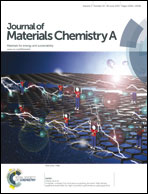Aqueous- and vapor-phase detection of nitroaromatic explosives by a water-stable fluorescent microporous MOF directed by an ionic liquid†
Abstract
A water-stable fluorescent microporous metal–organic framework (MOF), [Tb(L)(OH)]·x(solv) (1), has been designed and successfully synthesized under a combination of hydro/solvothermal and ionothermal conditions (H2L = 5-(4-carboxyphenyl)pyridine-2-carboxylate). The crystal structure reveals that complex 1 consists of cubane-shaped tetranuclear terbium building units, which are further bridged by the multicarboxylate ligands to give a (3,12)-connected topology with the point symbol (420·628·818)(43)4. More importantly, the excellent hydrolytic stability allows it to be used in an aquatic system, which is highly desirable for practical applications. Activated 1 shows high selectivity and sensitivity towards nitroaromatic explosives in both aqueous and vapor phases. The sizes of the pore windows (11.2 × 11.2 Å2) in 1, which are larger than the sizes of the selected nitroaromatics, could permit easy diffusion of analytes inside the channel, keeping the electron rich framework and electron deficient analytes in close proximity.


 Please wait while we load your content...
Please wait while we load your content...